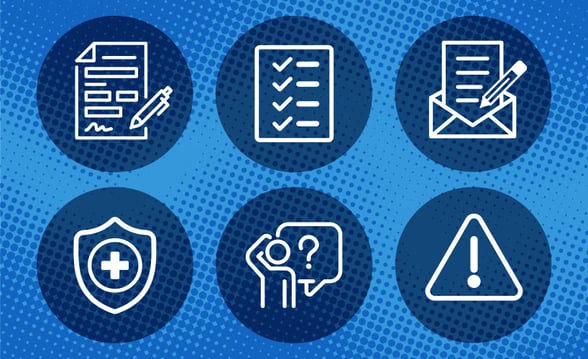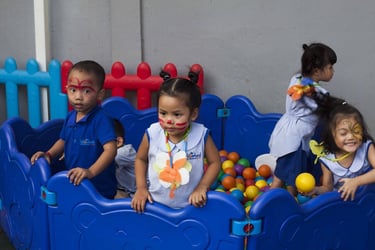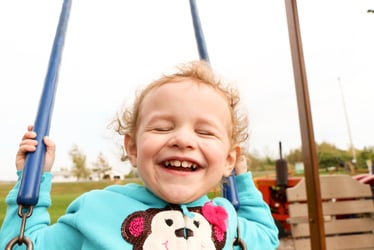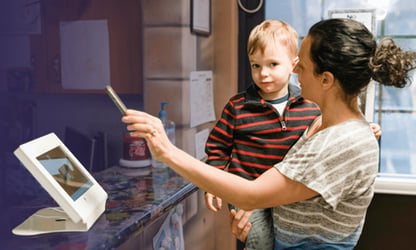Are you looking for fun and educational activities to engage your preschoolers starting in the springtime and continuing on through the summer?
Gardening is a fantastic way to stimulate young minds while teaching valuable new skills and promoting emotional development. Below, we'll explore the benefits of gardening for preschoolers, how to create a garden with them and various activities to keep them entertained and learning. From planting seeds to incorporating learning activities into a garden theme curriculum, we have all the tips and ideas you need to make gardening a successful and enriching experience for students, from a garden sensory bin to your very own preschool garden.
Table of Contents
- Why Is Gardening Beneficial for Preschoolers?
- How to Create a Garden with Preschoolers
- What Are Some Garden Activities for Preschoolers?
- How to Incorporate Garden Activities into the Curriculum
- FAQs
Why Is Gardening Beneficial for Preschoolers?

Gardening is like a playground filled with dirt, seeds and delicious rewards for young learners. It's a fantastic activity for preschoolers because it offers a wide range of benefits:
- Motor skills: Outdoor games like tag, hopscotch and Duck, Duck, Goose not only keep little ones active but also help in developing their gross motor skills. (University of Northern Iowa)
- Sensory perception: Sensory experiences and activities such as planting seeds, touching different textures and smelling various flowers enhance their sensory perception and cognitive skills. (Nebraska)
- Problem-solving skills: Nature scavenger hunts encourage observation, critical thinking and problem-solving, all essential for their overall growth. (Trabzon University)
- Environmental consciousness: Wildlife exploration, like bird watching or insect hunting, fosters curiosity and respect for the environment and fascinate preschoolers. (Otterbein University)
How to Create a Garden with Preschoolers

By involving preschoolers in gardening, you're creating a fun learning experience that will leave them with lasting memories and a newfound appreciation for the natural world around them. Here's how to get started:
Choose a Suitable Location
Selecting a suitable location for the garden creation process is crucial when engaging preschoolers in outdoor activities. Consider factors such as accessibility, sunlight exposure and the safety of garden tools to create an optimal learning environment for young learners.
- Accessibility plays a key role in ensuring that the garden area is easily reachable for children, allowing them to participate actively in planting and caring for the plants.
- Sunlight exposure is essential as it helps photosynthesis, educating preschoolers about the importance of sunlight in sustaining life.
- Safety considerations, such as selecting child-friendly tools and materials, not only protect the children but also introduce them to the concept of responsible gardening practices.
Gather Necessary Tools and Supplies
Before starting the garden project with preschoolers, ensure you have all the necessary tools and supplies ready. Some important tools and supplies to have on hand include:
- Child-sized shovels
- Rakes, gloves
- Watering cans
- Seeds
It's crucial to choose tools with rounded edges and ensure they are lightweight. When exploring garden wildlife with children, remember to teach them to observe from a safe distance. Encourage them to use binoculars or magnifying glasses to study birds, bugs and plants without causing any harm. For example, bug houses are a great way to study insects safely.
Involve the Children in Planning and Preparing the Garden
By involving children in the garden planning process, you instill a sense of responsibility and pride in them. This ownership leads to increased enthusiasm and dedication to caring for the garden. Engaging in garden crafts also nurtures their fine motor skills. Hands-on tasks like watering plants or digging in the soil provide valuable opportunities for physical coordination and strength building.
What Are Some Garden Activities for Preschoolers?

Incorporating seasonal gardening activities can further enhance the learning experience for young children. Here are a few gardening ideas for activities to get children involved.
Planting Seeds and Bulbs
Planting seeds and bulbs with preschoolers is a hands-on activity that introduces them to the wonders of nature exploration. This activity not only provides sensory benefits but also teaches children about the life cycle of plants and the importance of nurturing living things.
When planting bulbs or delicate little plants, be careful to instruct the preschoolers on how to handle them carefully. Younger children often don't understand just how fragile they can be.
Watering and Caring for Plants
Taking part in garden activities helps children develop a sense of ownership and responsibility toward their surroundings, fostering a deeper connection with the environment. By engaging with plants in a nurturing way, children can learn to grasp the concept of sustainability and conservation early on.
Harvesting Fruits and Vegetables
Engaging in such hands-on experiences not only exposes young minds to the vibrant and beautiful colors and diverse shapes found in nature, but also deepens their understanding of where their food comes from, whether it's a carrot, onion, radish or other garden vegetable they might put into a tasty salad or an herb like basil. This activity fosters a curiosity for exploring new flavors and textures, encouraging children to expand their palates and make healthier eating choices.
Bird Feeders
Winter may make planting impossible depending on your area, but wherever you live, it can be great spending time on bird feeders. Aside from creating lessons about the birds in your area while observing them from binoculars, one of the most popular activities involves crafting DIY bird feeders. One fun and low-cost activity are orange peel feeders. These can be a great way for kids to snack while providing a delicious treat for the neighborhood birds.
Making Garden Crafts
Other activities related to gardening include engaging preschoolers in making garden crafts. Crafts promote creative expression and artistry while aiding in the development of motor skills. By teaching preschoolers how to create garden crafts, they get the chance to paint vibrant flower pots, design and decorate colorful garden markers or even construct bird feeders using recyclable materials like old bottles and popsicle sticks.
If you're looking for a free printable to get started with garden crafts, try this one.
Tips for Gardening with Preschoolers
Although preschoolers are often very excited to work in a garden, you should follow a few tips, to ensure yours and their garden experience is positive and educational.
- To prevent overwatering, use a watering can that has a series of small holes at the end. This helps to slow the flow. Children often are eager to water and will overdo it, especially when you use a can that has a spout that allows water to spill out fast.
- To ensure plants are watered evenly, which is hard for many preschoolers, kindly direct and point to the next plant in the row.
- Because seeds are more durable and forgiving of pressure, they tend to be better for gardening activities for toddlers and preschoolers first learning how to garden.
- Larger seeds like peas and beans tend to be easier to handle for young ones without finely developed motor skills.
- Use repetition, especially when watching plants grow and harvesting. Kids tend to want to pick early as they are often overeager for the end product. Repeat sayings like, "When it's green leave it be, and when it's red, go ahead."
- One of the most important tips is to lower your expectations for the garden. Kids are learning and will likely overwater, harvest too early or break the stems of plants. This is fine, as the goal is to get them to learn about plants, herbs and what they need to grow and about key critters like worms and caterpillars.
How to Incorporate Garden Activities into the Curriculum
Integrating garden activities into the curriculum offers a multidisciplinary approach to learning for preschoolers. From scientific garden lessons on plant life cycles to math lessons involving measurements and counting seeds, garden-based education and lesson plans provide a rich platform for holistic development.
Language and literacy skills also blossom in the garden setting, as children engage in naming plants and their different parts, describing textures and discussing growth patterns. Reading books about gardening and writing journals about their observations further enhance their communication abilities.
Science Lessons: Plant Life Cycle and Photosynthesis
Learning about the plant life cycle and photosynthesis not only teaches children about the vital processes that sustain life on Earth but also instills a sense of responsibility toward caring for our planet. By grasping the interconnectedness of plants, sunlight and air in the process of photosynthesis, young minds begin to recognize the delicate balance of nature and the impact of human actions on the environment. Invite children to embrace hands-on activities like seed exploration, planting seeds, observing growth and tending to plants. Students will develop a kinship with the natural world, fostering a lifelong commitment to environmental stewardship.
Math Lessons: Measuring Plant Growth and Counting Seeds
Engaging in hands-on activities related to plant growth not only improves math proficiency but also offers sensory benefits through tactile experiences. By tracking the growth of plants, they learn to observe changes over time and apply mathematical principles to record data accurately. Exploring different types of seeds and predicting how they will grow fosters critical thinking and problem-solving skills.
If you're looking for a free math and nature counting printable to help you get started, here's one that blends numbers and gardening.
Language and Literacy Lessons: Reading and Writing About Plants
Language and literacy lessons centered on plants can significantly benefit preschoolers in several ways:
- Enhancing language development through reading and writing about gardening experiences
- Fostering communication skills and a love for learning by engaging with plant-related literature
- Boosting vocabulary and comprehension abilities by immersing young minds in the world of plants through books
- Stimulating curiosity and critical thinking by introducing diverse plant species and their characteristics
- Deepening understanding of nature and strengthening creative expression by exploring plant life cycles in stories and hands-on activities
- Enriching language skills while instilling environmental awareness and appreciation
Art Lessons: Creating Nature-Inspired Artwork
Working on nature-inspired art ideas encourages preschoolers to observe the intricacies of the environment, fostering their appreciation for the beauty that surrounds them. As they replicate natural elements in their artwork, such as flowers, trees or animals, children learn to pay attention to detail and develop fine motor skills. Engaging in art-making activities infused with natural themes is a fun way to cultivate empathy and compassion in young learners.
If you are looking for free printables to help you get started, here are a few nature coloring pages we've found inspire creativity and a sense of wonder of the outdoors.
Frequently Asked Questions
Are there any safety precautions I should take when doing garden activities with preschoolers?
Yes. Here are just a few critical safety rules you should follow (Oklahoma State University):
- Never leave a toddler or young child outdoors unattended.
- Ensure there is no access to the street or driveway from the children's play area.
- Use fences to help keep young children within the designated garden area, especially around stairs or decks.
- Teach children to never eat any plant unless an adult is supervising.
- Identify and remove any plants with spiny leaves or thorns that could pose a hazard.
- Fence off or remove any dangerous plants that are close to play areas.
- Do not use power lawn mowers when children are in the yard.
- Use tall stakes for plants that need support, as short stakes can cause eye injuries.
- Provide children with their own properly sized gardening tools.
- Do not allow children to be around when pesticides are being mixed or applied.
- Do not allow children to eat soil from the garden.
Can garden activities be done indoors if I don't have a garden?
Absolutely. You can do garden activities indoors by using planters, creating a small indoor garden or even doing activities that teach about composting and recycling. Using a seed planting tray or container is a great way to grow plants indoors any time of year, whether it's starting a sunflower or planting vegetables.
How can I make garden activities more educational for preschoolers?
You can make garden activities more educational by incorporating learning objectives into the activities, such as teaching about plant life cycles, different types of plants and the importance of pollinators. You can also have preschoolers keep a garden journal to document their observations and learnings.
Get 100+ Editable and Printable Templates for Almost Every Preschool Situation
We know preschools like yours are busy. That's why we made dozens of templates to help you manage the various aspects of your organization. With billing and invoicing, activity templates, forms and even marketing materials, we have it all. Download all 100 today!
References
- Aydin, Merve, "Understanding Problem-Solving Processes of Preschool Children in CS- Unplugged Activities," Trabzon University, International Journal of Computer Science Education in Schools, April 9, 2022, Vol. 5, No. 3 ISSN 2513-8359
https://files.eric.ed.gov/fulltext/EJ1345557.pdf - Smith, Brandy A. "An Investigation of Early Childhood Outdoor Play Areas and Social and Emotional Play." University of Northern Iowa, n.d. https://scholarworks.uni.edu/cgi/viewcontent.cgi?article=1932&context=etd
- Miller, Dana L. "The Seeds of Learning: Young Children Develop Important Skills through Their Gardening Activities at a Midwestern Early Education Program." International Journal of Computer Science Education in Schools, vol. 5, no. 3, Apr. 2022, pp. 252-259. https://www.tandfonline.com/doi/abs/10.1080/15330150701318828
- "Impact of Animal Programming on Children's Attitudes Toward Local Wildlife." Department of Biology and Earth Science, Otterbein University, Westerville, Ohio, USA. https://onlinelibrary.wiley.com/doi/full/10.1002/zoo.21787
- Oklahoma State University Extension. (n.d.). Garden Safety with Kids. https://extension.okstate.edu/county/ottawa/media/docs/fcs/garden-safety-with-kids.pdf












